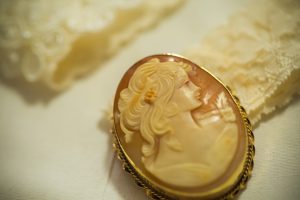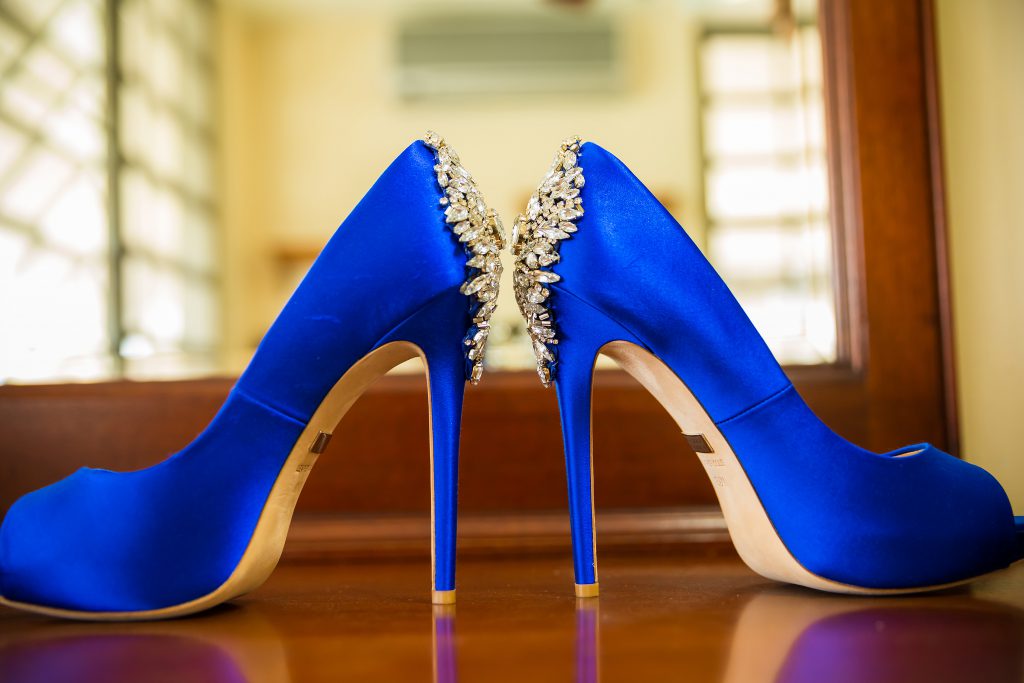 I’ve been a bridesmaid in four weddings. In each of these weddings, the bride has carefully chosen four special items to wear on her wedding day: something old, something new, something borrowed, and something blue. And when preparing for the first three weddings, I didn’t think much of the custom. But when my sister-in-law got married in April, and showed me her something old, new, borrowed, and blue, I couldn’t help but think: why on earth are women doing this? ‘Something old, new, borrowed, blue’? Did my mother do it? My grandmother? My great-grandmother?
I’ve been a bridesmaid in four weddings. In each of these weddings, the bride has carefully chosen four special items to wear on her wedding day: something old, something new, something borrowed, and something blue. And when preparing for the first three weddings, I didn’t think much of the custom. But when my sister-in-law got married in April, and showed me her something old, new, borrowed, and blue, I couldn’t help but think: why on earth are women doing this? ‘Something old, new, borrowed, blue’? Did my mother do it? My grandmother? My great-grandmother?
Turns out – after a quick survey of my married female colleagues – the answer is yes: women have been participating in this tradition for several decades. And when I asked my mother, she also confirmed that she gathered the four items in 1977. (She couldn’t remember the items, but she insisted that she did it.) So, the tradition was not a new one. And, once I started looking into it, I found some very interesting details about this particular wedding custom.
First, the tradition comes from an old verse:
Something old, something new
Something borrowed, something blue
And a sixpence in the shoe
The author of the verse is unknown, and there seems to be some debate over when it first appeared: some sources claimed it as “an ancient nursery rhyme from England,”[1] while others call it “a saying that dates to Victorian times…”[2] During a quick search, I was able to locate an 1894 newspaper article from the Grand Forks Daily Herald that referred to Puritan Marriage Customs. One of the customs mentioned was that “the bride was universally advised to wear: Something old, something new, Something borrowed, something blue…”[3] This particular reference removed the “sixpence in the shoe” line, yet the article referred to the tradition with such informality that we can assume that the tradition was common for the period.
Second, what it the significance of the old, new, borrowed, blue items?
Again, there seems to be much debate over the meaning. Contemporary references claim the “old” represents the bride’s link with the past while the “new” promotes good fortune for the new life of the bride. The “borrowed” should come from someone who has been happily married for several years, to “transfer” happiness to the newlywed couple, and the “something blue” symbolizes true love, loyalty, and fidelity.[4] However, older articles, such as an 1898 article from Folklore, a journal published by the Folklore Society of Great Britain, explain that the “something old” and “something blue” are devices to baffle the Evil Eye. The usual effect on the bride of the Evil Eye is to render her barren, and this is obviated by wearing “something borrowed,” which should properly be the undergarment of some woman who has been blessed with children: the clothes communicate fertility to the bride.”[5] This is a much darker take on the custom, and presents the practice as a superstition, rather than a tradition.
Finally, why are women doing it?
I am going to argue that brides currently participate in this custom because they consider it to be family tradition, not superstition. I say this because, if women have been selecting items (old, new, borrowed, and blue) since (at least) the 1890s, it is family tradition. Their mothers did it, their grandmothers and great-grandmothers, too – maybe not each and every one of them – but more than likely one female ancestor did. Therefore, I am confident that women (especially my new sister-in-law) chose to participate in the practice to further family tradition, and not superstition. My brother and sister-in-law are too perfect for each other to believe in superstition – but still, those shoes!!
Postscript: My sister-in-law’s choices were gorgeous:
Old: A pin (cameo) from her deceased paternal grandmother
New: Her wedding dress
Borrowed: Her headpiece, which was worn by two of her cousins on her paternal side
Blue: Her show-stopping Manolo Blahnik shoes
Notes
[1] Les Stubbs and Benjamin J. West, 2000 Weddings but no Funerals! (Central Milton Keynes, Authorhouse, 2011), p. 191.
[2] Valerie and Lyle MacPherson, The Celtic Wedding Planner (Celtic Wedding Planner, 2012).
[3] “Puritan Marriage Customs. Startling Bible Texts Sometimes Selected for the Wedding Sermon,” Grand Forks Daily Herald, Wednesday, 19 September 1894, p. 1.
[4] Monica-Maria Stapelberg, Strange but True: a Historical Background to Popular Beliefs and Traditions (Crux Publishing, 2014).
[5] W. Crooke, “The Wooing of Penelope,” Folklore 9 [June 1898]: 128.

This didn’t come into my family until we started having church weddings in the 1930s.
My daughter and I both wore my paternal grandmother’s engagement ring as our something old. It was purchased in 1914 and has a central amethyst, flanked by two pearls.
I did this and my grandmother (she came from Leeds, Yorkshire, England through Ellis Island in 1915) gave me a six pence to put in my shoe. I saved it and let my daughter wear it for her wedding three years ago!
When I went to the UK in 1968, when it was just transitioning from shillings and pence to decimal, I brought back a sixpence for family weddings. It was used a number of times, including by my sister and my niece in about 1992. I wish I knew where it is now.
Thank you for the interesting article.
This essay in itself is a beautiful gift for the bride and groom.
My grand mother who married in 1904 wore a blue garter with a silver coin attached. The brides in our family have worn it since.
Nice story. I bought several silver sixpences in the UK years ago from a shop near the British Museum to give to brides. It must have been a common request because they had a bowl of them on the counter, non coin collector quality! I make a garter with gathered satin ribbon, elastic and a tiny blue rosette, and I have a stash of old lace handkerchiefs. So the brides in our family are outfitted according to tradition.
When I was married in 1965 a local bridal shop gave a free sixpence to each engaged girl that came into the store. It was the first I had heard of the last line of the poem. I have lent my coin to several brides.
Something old (or was it borrowed? maybe both) was a small, antique beaded purse. Both my sister and I carried it at our weddings. For me, blue was a garter. Don’t know what was new – probably my wedding dress ;-). I think it is a nice tradition and if my daughters marry, I would definitely follow it.
When I married in 1973 it was definitely considered a “very old tradition” and also a superstition. If you didn’t follow it to the letter, it was considered bad luck, and therefore never questioned. Typical objects borrowed were handkerchiefs, rings, clothing (to fool the fairies about your identity so they wouldn’t be able to identify you clearly and play bad tricks and ruin your day). I personally, wore a wedding dress partly made from my mother’s (old, borrowed and new), also my grandmothers lace hankie and grandfather’s wedding ring (old and borrowed from a couple with over 50 years marriage and 4 children) and a blue garter (all probably sexuality/fertility talismans); and a penny in my shoe (money is always a clear superstitious talisman for good fortune). The garter, too, is tied to the sexuality side of things, as it was meant to go above the knee, to be removed at the end of the festivities by the best man!!!!! I see it like an advertisement about the attractive fertility of the woman, and this is a big part of marriage ceremonies in mediterranean cultures as the final act sending off the couple to their marriage bed. My own cultural traditions would have been influenced by English, Irish heritage and possibly the dominant Swedish culture of my town.
We have a family half-dime which has now been worn for 5 generations (my great grandmother, grandmother, mother, me, both daughters) – I just hope I’m able to witness my granddaughter (or future granddaughter) wearing it, as well. We were told it was supposed to be in the heel of the left shoe which is what we all did.
I had a family handkerchief (from my great grandmother and used by all of us) as “old”, wedding dress as “new”, pearl bracelet borrowed from my sister, and a blue garter.
Thank you for the memories.
Nice thinking up to that point. Can we go a little further? Think of other things we do by tradition, custom or standardized behavior. All those may have started their existence as superstition at the time, and then move slowly as tradition… as everybody forgot the start of it. Called superstition today ‘a posteriori’ but at the beginning being a plausible cause-effect explanation of whatever happened just before. Closer to us now, it looks like superstition because ‘we know better’. But still, no good reason to repeat these except to be recognize as part of a group while recognizing ancestors doings. Does this make it brilliant? To each his answer. /// Further on this line of thinking, can we add religious ‘believes’, simple acts of everyday life (like the way we salute others), learning by imitating… Does anything of this means we have to throw all old now-proven superstition to the garbage. Again, to each his choice to be respected by others.
I would think this tradition has come down from a very distant past when the “evil eye” really meant something, and the threat of being barren was a serious issue. Do not discount sympathetic magic! Of course, it has taken on new meaning for different places over the decades (centuries?). I was married in Scotland in 2001, and along with the old, new, borrowed and blue, I put that sixpence in my shoe.
When I married in 1968, I didn’t think about any of these traditions. However, I did wear something new–my wedding dress. My mother loaned me her string of pearls, a gift from my father years after they were married. My sister later wore them in her wedding. They weren’t all that old, but I suppose they qualify as both “borrowed” and “old.” My dress was jade green (I look terrible in white), and short, as the ceremony was very small. My then-sister-in-law gave me a garter, which had blue in it. One of the pictures has me showing it off, and given the length of skirts in 1968, that picture showed how high I had to wear the garter so it didn’t show! When we looked at the pictures later, my husband and I laughed, as we’d been unaware that there were exactly thirteen people there! Neither our marriage nor my brother’s lasted, and neither of us had children by that marriage. So whatever those traditions were “supposed” to do for us, they didn’t! Maybe if we’d had a sixpence, we’d have done better. Or, even better, if we’d chosen our spouses more wisely the first time around.
I had not heard of the sixpence part of the rhyme, but I did have a penny in my shoe when I got married in 1987! And I did the new/old/borrowed/blue as well.